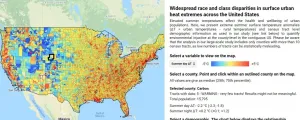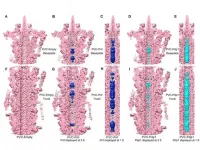(Press-News.org) Middle- to older-aged adults who ate at least three servings of whole grains daily had smaller increases in waist size, blood pressure, and blood sugar levels over time compared to those who ate less than one-half serving per day, according to new research.
Published July 13, 2021, in the Journal of Nutrition, the study by researchers at the Jean Mayer USDA Human Nutrition Research Center on Aging at Tufts University examined how whole- and refined-grain intake over time impacted five risk factors of heart disease: Waist size, blood pressure, blood sugar, triglyceride, and HDL ("good") cholesterol.
Using data from the Framingham Heart Study Offspring Cohort, which began in the 1970s to assess long-term risk factors of heart disease, the new research examined health outcomes associated with whole- and refined-grain consumption over a median of 18 years. The 3,100 participants from the cohort were mostly white and, on average, in their mid-50s at the start of data collection.
The research team compared changes in the five risk factors, over four-year intervals, across four categories of reported whole grain intake, ranging from less than a half serving per day to three or more servings per day. According to the Dietary Guidelines for Americans 2020-2025, the recommended amount of whole grains is three or more servings daily. An example of a serving is one slice of whole-grain bread, a half cup of rolled oats cereal, or a half cup of brown rice.
The results showed that for each four-year interval:
Waist size increased by an average of over 1 inch in the low intake participants, versus about ½ inch in the high intake participants.
Even after accounting for changes in waist size, average increases in blood sugar levels and systolic blood pressure were greater in low intake participants compared to high intake participants.
The researchers also studied the five risk factors across four categories of refined-grain intake, ranging from less than two servings per day to more than four servings per day. Lower refined-grain intake led to a lower average increase in waist size and a greater mean decline in triglyceride levels for each four-year period.
"Our findings suggest that eating whole-grain foods as part of a healthy diet delivers health benefits beyond just helping us lose or maintain weight as we age. In fact, these data suggest that people who eat more whole grains are better able to maintain their blood sugar and blood pressure over time. Managing these risk factors as we age may help to protect against heart disease," said Nicola McKeown, senior and corresponding author and a scientist on the Nutritional Epidemiology Team at the USDA HNRCA.
"There are several reasons that whole grains may work to help people maintain waist size and reduce increases in the other risk factors. The presence of dietary fiber in whole grains can have a satiating effect, and the magnesium, potassium, and antioxidants may contribute to lowering blood pressure. Soluble fiber in particular may have a beneficial effect on post-meal blood sugar spikes," said Caleigh Sawicki. Sawicki did this work as part of her doctoral dissertation while a student at the Gerald J. and Dorothy R. Friedman School of Nutrition Science and Policy at Tufts University and while working with the Nutritional Epidemiology Team at the USDA HNRCA.
The greatest contributor to whole-grain intake among participants was whole-wheat breads and ready-to-eat whole-grain breakfast cereals. The refined grains came mostly from pasta and white bread. The difference in health benefits between whole and refined grains may stem from the fact that whole grains are less processed than refined grains. Whole grains have a fiber-rich outer layer and an inner germ layer packed with B vitamins, antioxidants, and small amounts of healthy fats. Milling whole grains removes these nutrient-dense components, leaving only the starch-packed refined grain behind.
"The average American consumes about five servings of refined grains daily, much more than is recommended, so it's important to think about ways to replace refined grains with whole grains throughout your day. For example, you might consider a bowl of whole-grain cereal instead of a white flour bagel for breakfast and replacing refined-grain snacks, entrees, and side dishes with whole-grain options. Small incremental changes in your diet to increase whole-grain intake will make a difference over time," McKeown said.
Methodology
To measure daily grain intake, the researchers used diet questionnaires that participants completed every four years from 1991 to 2014, resulting in a median of 18 years of data.
Dietary assessment data came from five study examinations, and observations were only included if participants attended at least two consecutive examinations with accurate dietary data. Participants with diabetes at baseline were excluded.
The statistical analysis was adjusted for factors that might influence the results, including other aspects of a healthy diet. Limitations of the study include the fact that food consumption is self-reported, and participants may over- or under-estimate intake of certain foods based on perceived social desirability. Due to its observational design, the study does not reflect a causal relationship.
INFORMATION:
Authors and Funding
Additional authors on the study are Paul Jacques, Alice Lichtenstein, Gail T. Rogers of the USDA HNRCA, and Jiantao Ma and Edward Saltzman of the Friedman School.
This work was supported by USDA's Agricultural Research Service, the General Mills Bell Institute of Health and Nutrition, and the National Institutes of Health's National Heart, Lung, and Blood Institute (Framingham Heart Study). The content is solely the responsibility of the authors and does not necessarily represent the official views of the National Institutes of Health. Please see the study for conflicts of interest.
Philadelphia, July 13, 2021 - Consumers may have less trust in food processes that they don't understand, and animal-based foods may be subject to more uninformed scrutiny than other foods due to consumers' perception of higher risk. Dairy producers can benefit from understanding how consumers interpret unfamiliar terms and claims on dairy product labels. In a new END ...
New research from the University of Nebraska-Lincoln has shown that the mutations arising in the COVID-19-causing SARS-CoV-2 virus seem to run in the family -- or at least the genus of coronaviruses most dangerous to humans.
After comparing the early evolution of SARS-CoV-2 against that of its closest relatives, the betacoronaviruses, the Nebraska team found that SARS-CoV-2 mutations are occurring in essentially the same locations, both genetically and structurally.
The mutational similarities between SARS-CoV-2 and its predecessors, including the human-infecting SARS-CoV-1 and MERS-CoV, could help inform predictions of how the COVID-causing virus will continue to evolve, the researchers ...
Amsterdam, July 13, 2021 - Mass spectrometry has emerged as an important analytical tool for gaining a better understanding of mechanisms underlying Huntington's disease (HD), alongside the increased availability of cell and animal models of the disease. This END ...
YorkU pain research finds what you say in the first minute after a vaccine can be key in reducing a child's future distress
New study finds it's not just what say, but when you say it that can keep preschoolers calmer during vaccinations
TORONTO, July 13, 2021 - As we look forward to a fall with hopefully one of the most important vaccination uptakes of children in a generation, a new study provides insights to help parents with reducing post-vaccination distress in younger kids. The study, published in END ...
WASHINGTON--In cities and towns across the United States, neighborhoods with more Black, Hispanic and Asian residents experience hotter temperatures during summer heatwaves than nearby white residents, a new study finds. It is the first to show that the trend, documented in some major cities, is widespread, even in small towns, nationwide.
According to the new nationwide study, these racial disparities exist because non-white neighborhoods tend to be more densely built up with buildings and pavement that trap heat and have fewer trees to cool the landscape.
"Urban climate is different from temperatures outside the city," said co-author Susanne Benz, an ...
Antimicrobials are used to kill or slow the growth of bacteria, viruses and other microorganisms. They can be in the form of antibiotics, used to treat bodily infections, or as an additive or coating on commercial products used to keep germs at bay. These life-saving tools are essential to preventing and treating infections in humans, animals and plants, but they also pose a global threat to public health when microorganisms develop resistance to them, a concept known as antimicrobial resistance.
One of the main drivers of antimicrobial resistance is the misuse and overuse of antimicrobial agents, which includes silver nanoparticles, ...
The COVID-19 pandemic caused an unprecedented disruption to health care delivery, with resources shifted toward telehealth services and mass viral testing. While early studies in the pandemic highlighted differences in health care utilization among patients with commercial insurance, data from publicly insured or uninsured "safety-net" patient populations continue to emerge.
A recent study from researchers at the University of Minnesota and Hennepin Healthcare Research Institute (HHRI) is among the first to examine how different socio-demographic groups used telehealth, outpatient (i.e., clinic), emergency department and inpatient (i.e., hospital) care to test for SARS-CoV-2, the virus that causes COVID-19. ...
In particle physics, a Majorana Fermion is charge neutral and its antiparticle is just itself. In condensed matter physics, a Majorana zero mode (MZM) is a quasi-particle excitation, which appears in the surfaces or edges of topological superconductors. Unlike the ordinary particles or quasi-particles that obey boson or fermion statistics, MZM obeys non-abelian statistics, a key property that makes MZM the building block for realizing topological quantum computation. Currently major experimental efforts focus on heterostructures made of superconductors and spin-orbit coupled systems (such as semiconducting nano-wires and topological insulators), where evidences of MZMs have been found. Unambiguous detection and manipulation of MZMs in these heterostructures, ...
North Carolina State University researchers have created insecticide-free, mosquito-resistant clothing using textile materials they confirmed to be bite-proof in experiments with live mosquitoes. They developed the materials using a computational model of their own design, which describes the biting behavior of Aedes aegypti, the mosquito that carries viruses that cause human diseases like Zika, Dengue fever and yellow fever.
Ultimately, the researchers reported in the journal Insects that they were able to prevent 100 percent of bites when a volunteer wore their clothing - a base layer undergarment and a combat shirt initially designed for the military - in a cage with 200 live, disease-free mosquitoes. Vector Textiles, an NC State startup company, ...
Contractile injection systems (CISs) are widely distributed in bacteria and archaea that can form a nanomachine resembling the contractile tails of bacteriophage (T4, P2, etc.) to translocate proteins and nucleic acids . The P. asymbiotica was shown to be involved in the human infection with severe skin lesions. The PVC loci within P. asymbiotica genome produce molecular needle complexes and encode several putative effector genes. It would be a candidate P. asymbiotica weapon that participates in the attack of mammalian cells, but substantial evidences will be needed to verify this hypothesis.
In this study, researchers have characterized the PAU_RS16575 as a potent PVC effector, which is widely present in bacteria. ...




